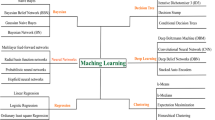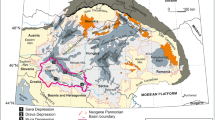Abstract
Surface-based modelling provides a computationally efficient approach for generating geometrically realistic representations of heterogeneity in reservoir models. However, conditioning Surface-Based Geological Models (SBGMs) to well data can be challenging because it is an ill-posed inverse problem with spatially distributed parameters. To aid fast and efficient conditioning, we use here SBGMs that model geometries using parametric, grid-free surfaces that require few parameters to represent even realistic geological architectures. A neural network is trained to learn the underlying process of generating SBGMs by learning the relationship between the parametrized SBGM inputs and the resulting facies identified at well locations. To condition the SBGM to these observed data, inverse modelling of the SBGM inputs is achieved by replacing the forward model with the pre-trained neural network and optimizing the network inputs using the back-propagation technique applied in training the neural network. An analysis of the uncertainties associated with the conditioned realisations demonstrates the applicability of the approach for evaluating spatial variations in geological heterogeneity away from control data in reservoir modelling. This approach for generating geologically plausible models that are calibrated with observed well data could also be extended to other geological modelling techniques such as object- and process-based modelling.
Article PDF
Similar content being viewed by others
Avoid common mistakes on your manuscript.
References
Jackson, M.D., Percival, J.R., Mostaghimi, P., Tollit, B.S., Pavlidis, D., Pain, C.C., Gomes, J.L.M.A., El-Sheikh, A.H., Salinas, P., Muggeridge, A.H., Blunt, M.J.: Reservoir modeling for flow simulation by use of surfaces, adaptive unstructured meshes, and an overlapping-control-volume finite-element method. SPE Reservoir Evaluation and Engineering 18, 115–132 (2015)
Osman, H., Graham, G.H., Moncorge, A., Jacquemyn, C., Jackson, M.D.: Is cell-to-cell scale variability necessary in reservoir models? Mathematical Geosciences (2020)
Salinas, P., Pavlidis, D., Xie, Z., Jacquemyn, C., Melnikova, Y., Jackson, M.D., Pain, C.C.: Improving the robustness of the control volume finite element method with application to multiphase porous media flow. Int. J. Numer. Methods Fluids 85, 235–246 (2017)
Karssenberg, D., Törnqvist, T.E., Bridge, J.S.: Conditioning a process-based model of sedimentary architecture to well data. J. Sediment. Res. 71(6), 868–879 (2001)
Pyrcz, M.J., Catuneanu, O., Deutsch, C.V.: Stochastic surface-based modeling of turbidite lobes. AAPG Bulletin 89(2), 177–191 (2005)
Michael, H.A., Li, H., Boucher, A., Sun, T., Caers, J., Gorelick, S.M.: Combining geologic-process models and geostatistics for conditional simulation of 3-D subsurface heterogeneity. Water Resour. Res. 46(5) (2010)
Zhang, X., Pyrcz, M.J., Deutsch, C.V.: Stochastic surface modeling of deepwater depositional systems for improved reservoir models. J. Pet. Sci. Eng. 68, 118–134 (2009)
Parquer, M.N., Collon, P., Caumon, G.: Reconstruction of channelized systems through a conditioned reverse migration method. Math Geosci. 49, 965–994 (2017)
Bertoncello, A., Sun, T., Li, H., Mariethoz, G., Caers, J.: Conditioning surface-based geological models to well and thickness data. Math. Geosci. 45, 873–893 (2013)
Wang, Y.C., Pyrcz, M.J., Catuneanu, O., Boisvert, J.B.: Conditioning 3D object-based models to dense well data. Comput. Geosci. 115, 1–11 (2018)
Wingate, D., Kane, J., Wolinsky, M., Sylvester, Z.: A new approach for conditioning process-based geological models to well data. Math Geosci. 48, 371–397 (2016)
Dramsch, J.S.: 70 years of machine learning in geoscience in review. Adv. Geophys. 61, 1–55 (2020)
Ma, X., Zhang, J., Zhao, H.: Application of artificial neural networks in lithofacies interpretation used for 3D geological modelling. Second ISECS International Colloquium on Computing, Communication, Control, and Management 4, 451–454 (2009)
Maiti, S., Tiwari, R.K., Kümpel, H.: Neural network modelling and classification of lithofacies using well log data: A case study from KTB borehole site. Geophys. J. Int. 169, 733–746 (2007)
Brcković, A., Kovačević, M., Cvetković, M., Kolenković Močilac, I., Rukavina, D., Saftić, B.: Application of artificial neural networks for lithofacies determination based on limited well data. Central European Geology 60, 299–315 (2017)
Wang, Z., Di, H., Shafiq, M.A., Alaudah, Y., AlRegib, G.: Successful leveraging of image processing and machine learning in seismic structural interpretation: A review. The Leading Edge. 37(6), 451–461 (2018)
Liu, Y., Wang, L., Shuai, Y., Zhang, Y., Liu, Z., Chen, Z.: Quantitative seismic interpretations to detect biogenic gas accumulations: a case study from Qaidam Basin, China. Bull. Can. Pet. Geol. 63 (1), 108–121 (2015)
Fu, H., Zhang, Y., Ma, M.: Seismic waveform inversion using a neural network-based forward. Journal of Physics: Conference Series, 1324 (2019)
Mosser, L., Dubrule, O., Blunt, M.J.: Stochastic seismic waveform inversion using generative adversarial networks as a geological prior. Math Geosci. 52, 53–79 (2020)
Dupont, E., Zhang, T., Tilke, P., Liang, L., Bailey, W.: Generating realistic geology conditioned on physical measurements with generative adversarial networks. arXiv:1802.03065 (2018)
Laloy, E., Hérault, R., Jacques, D., Linde, N.: Efficient training-image based geostatistical simulation and inversion using a spatial generative adversarial neural network. arXiv:1708.04975 (2017)
Chan, S., Elsheikh, A.H.: Parametrization and generation of geological models with generative adversarial networks. arXiv:1708.01810 (2017)
Zhou, C., Ouyang, J., Ming, W., Zhang, G., Du, Z., Liu, Z.: A stratigraphic prediction method based on machine learning. Appl. Sci. 9, 3553 (2019)
Chan, S., Elsheikh, A.H.: Parametric generation of conditional geological realizations using generative neural networks. Comput. Geosci. 23, 925–952 (2019)
Jo, H., Santos, J.E., Pyrcz, M.J.: Conditioning well data to rule-based lobe model by machine learning with a generative adversarial network. Energy Exploration & Exploitation 38(6), 2558–2578 (2020)
Jackson, M.D., Hampson, G.J., Saunders, J.H., El-Sheikh, A., Graham, G.H., Massart, B.Y.G.: Surface-based reservoir modelling for flow simulation. Book Series: Geological Society Special Publication 387, 271–292 (2013)
Piegl, L., Tiller, W.: The NURBS Book. Monographs in Visual Communications, pp 128–140. Springer, Berlin, Heidelberg (1997)
Jacquemyn, C., Jackson, M.D., Hampson, G.J.: Surface-based geological reservoir modelling using grid-free NURBS curves and surfaces. Math. Geosci., 51 (2019)
Rønning, K., Steel, R.J.: Depositional sequences within a “transgressive” reservoir sandstone unit: The middle Jurassic Tarbert formation, Hild area, Northern North Sea, North Sea oil and gas reservoirs, 169–178 (1987)
Sech, R.P., Jackson, M.D., Hampson, G.J.: Three-dimensional modeling of a shoreface-shelf parasequence reservoir analog: Part 1. surface-based modeling to capture high-resolution fades architecture. AAPG Bulletin. 93, 1155–1181 (2009)
Bishop, C.M.: Pattern recognition and machine learning (Information science and statistics), p 209. Springer, Berlin, Heidelberg (2006)
Kingma, D.P., Ba, J.: Adam: A method for stochastic optimization. arXiv:1412.6980(2015)
Rumelhart, D.E., Hinton, G.E., Williams, R.J.: Learning Internal Representations by Error Propagation. Parallel Distributed Processing: Explorations in the Microstructure of Cognition, vol. 1, foundations, pp 318–362. MIT Press, Cambridge (1986)
Schlumberger: Wireline Services Catalog (Schlumberger Methods) (2015)
Pyrcz, M.J., Sech, R.P., Covault, J.A., Willis, B.J., Sylvester, Z., Sun, T.: Stratigraphic rule-based reservoir modeling. Bull. Can. Pet. Geol. 63(4), 287–303 (2015)
LeCun, Y., Bottou, L., Bengio, Y., Haffner, P.: Gradient-based learning applied to document recognition. Proceedings of the IEEE 86(11), 2278–2324 (1998)
Zhang, D., Chen, Y., Meng, J.: Synthetic well logs generation via recurrent neural networks. Petroleum Exploration and Development 45(4), 629–639 (2018)
Hochreiter, S., Schmidhuber, J.: Long short-term memory. Neural Comput. 9(8), 1735–1780 (1997)
Grana, D., Azevedo, L., Liu, M.: A comparison of deep machine learning and Monte Carlo methods for facies classification from seismic data. Geophysics 85(4), WA41–WA52 (2020)
Acknowledgements
The authors would like to acknowledge the Petroleum Technology Development Fund (PTDF) and the following EPSRC grants: MUFFINS (EP/P033180/1); MAGIC (EP/N010221/1); PREMIERE (EP/T000414/1) and INHALE (EP/T003189/1). The authors also appreciate the editor-in-chief, guest editor, and the reviewers for their constructive reviews and comments.
Author information
Authors and Affiliations
Corresponding author
Additional information
Publisher’s note
Springer Nature remains neutral with regard to jurisdictional claims in published maps and institutional affiliations.
Rights and permissions
Open Access This article is licensed under a Creative Commons Attribution 4.0 International License, which permits use, sharing, adaptation, distribution and reproduction in any medium or format, as long as you give appropriate credit to the original author(s) and the source, provide a link to the Creative Commons licence, and indicate if changes were made. The images or other third party material in this article are included in the article's Creative Commons licence, unless indicated otherwise in a credit line to the material. If material is not included in the article's Creative Commons licence and your intended use is not permitted by statutory regulation or exceeds the permitted use, you will need to obtain permission directly from the copyright holder. To view a copy of this licence, visit http://creativecommons.org/licenses/by/4.0/.
About this article
Cite this article
Titus, Z., Heaney, C., Jacquemyn, C. et al. Conditioning surface-based geological models to well data using artificial neural networks. Comput Geosci 26, 779–802 (2022). https://doi.org/10.1007/s10596-021-10088-5
Received:
Accepted:
Published:
Issue Date:
DOI: https://doi.org/10.1007/s10596-021-10088-5




